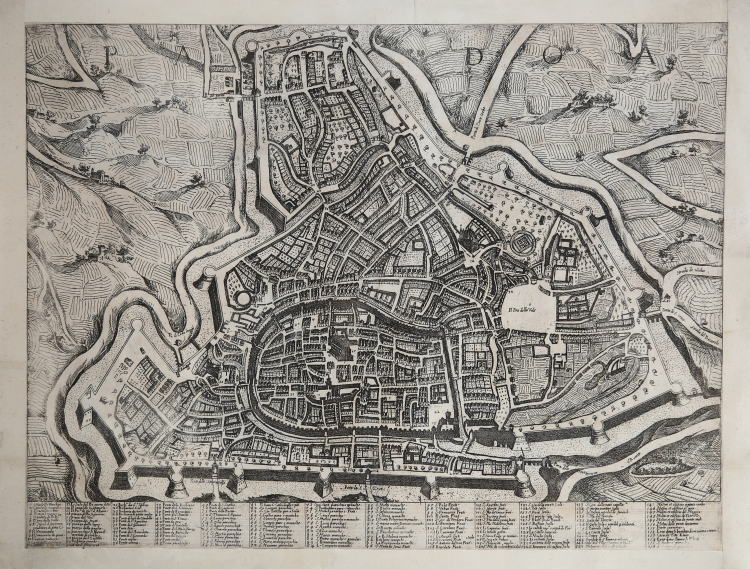



| Reference: | S38291 |
| Author | Matteo FLORIMI |
| Year: | 1600 ca. |
| Zone: | Padova |
| Printed: | Siene |
| Measures: | 552 x 415 mm |


| Reference: | S38291 |
| Author | Matteo FLORIMI |
| Year: | 1600 ca. |
| Zone: | Padova |
| Printed: | Siene |
| Measures: | 552 x 415 mm |
Under the upper edge, in very large characters, the title is engraved: PADOA. Along the lower margin, numerical legend of 156 references to notable places and monuments, distributed over thirteen columns.
“The axonometric plan of Padua by Giuseppe Viola Zanini will be the reference prototype for the design of the city until that of Giovanni Valle in 1784. Published by Matteo Florimi at the end of the 16th century, it is the first map to give a reliable image of the city and its fortified walls; it shows the urban consistency well even if probably "delivered in terms of probable aggregations rather than as a result of survey operations". The most important buildings are represented such as the Palazzo della Ragione, Castelvecchio, the chapel of the Arena and the Saint, as well as the Botanical Garden and the main roads that led from Padua to Venice, Piove di Sacco, Conselve and Monselice. Florimi map will know a large number of constantly updated replicas, from the Patavium nobilissima published in the sixth volume of the Civitates Orbis Terrarum (1618) up to the eighteenth-century ones, including that of De Wit” (cf. Cartografia e Topografia Italiana del XVI secolo, p. 2274).
Etching and engraving, printed on contemporary laid paper without watermark, trimmed on copper and with contemporary margins added, small restorations in the lower part, otherwise in good condition.
Very rare work, registered for only 8 institutional specimens according Bifolco-Ronca (cf Cartografia e Topografia Italiana del XVI secolo,, p. 2274).
Matteo Florimi (Polistena c. 1540 - Siena 1613) was a publisher and merchant of books and prints. Of Calabrian origin, he settled in Siena in 1581, with a store “in Banchi”. Matteo Florimi's chalcographic activity was several times joined by master engravers such as Cornelis Galle, Arnoldo Arnoldi, Pieter de Iode, Jan Sadeler and artists such as Francesco Vanni, Ventura Salimbeni and Alessandro Casolani, with whom the printer collaborated in the preparation of religious subjects. Florimi's cartographic activity produced prints of many cities and territories around the world, which were never drawn for him, but were manipulations of already existing reliefs, or of maps published by other printers. In the second half of the sixteenth century, Florimi was far-sighted in devoting himself to the production of bird's-eye views of cities as faithfully as possible. Florimi copied some maps by Antonio Lafreri, Claude Duchet, Abraham Ortelius. As far as map engraving work was concerned, in 1600, Matteo Florimi called the Flemish engraver Arnoldo degli Arnoldi to work in his workshop with the promise of greater compensation than that bestowed upon him by Giovanni Antonio Magini, with whom the artist was working. This offer by Florimi triggered the wrath of Magini, who, though not naming him, called him an "envious counterfeiter" for stealing such a skilled cartographer from him. The collaboration between Florimi and Arnoldi lasted only two years (1600-1602), but it was quite productive: together they printed the Stato di Siena, la Choronografia Tusciae, la Nuova descrittione della Lombardia, l’Europa, l’America and the Descrittione Universale della Terra.
Bibliografia
Bifolco-Ronca, Cartografia e Topografia Italiana del XVI secolo (2018), tav. 1167; H.A.M. van der Heijden, Matteo Florimi (+1613) – Landkarten und Stadtplanverleger in Siena, in “Florilegium Cartographicum”, Lipsia (1993): n. 33; Cartografia Rara (1986): n. 93; Christie’s (2011): n. 6; Ganado (1994): III, n. 199 e VII, n. 41; Shirley (2004): III, n. 46; Benevolo (1969): pp. 84-86, tav. XVII; L’Immagine delle città italiane (1998): pp. 161-162, n. 56; Ghironi (1985): n. 11; cfr. Hopknis (2001).
Matteo FLORIMI (Polistena 1540 circa - Siena 1613)
|
Print and book dealer and publisher, from Calabria. He came to Siena c.1581.Shop in Banchi. The first evidence of his independent activity is of 1589. In 1591 he published a book of patterns for lace, The Fiori di ricami, in Venice, and in 1593 a second edition in Siena.
In 1597 he published the Life of St Catherine, engraved by De Jode after Vanni, and the Passion of Christ by De Jode after Andrea Boscoli. He published a large number of maps and figural prints are mostly religious. He employed engravers of the calibre of Agostino Carracci, Cornelis Galle, Pieter de Jode Villamena and Thomassin, among others.
He commissioned drawings from Andrea Boscoli. He had a particularly close relationship with Vanni. In the years 1605-8, Florimi received financial support from Ottavio Cinuzzi.
|
Matteo FLORIMI (Polistena 1540 circa - Siena 1613)
|
Print and book dealer and publisher, from Calabria. He came to Siena c.1581.Shop in Banchi. The first evidence of his independent activity is of 1589. In 1591 he published a book of patterns for lace, The Fiori di ricami, in Venice, and in 1593 a second edition in Siena.
In 1597 he published the Life of St Catherine, engraved by De Jode after Vanni, and the Passion of Christ by De Jode after Andrea Boscoli. He published a large number of maps and figural prints are mostly religious. He employed engravers of the calibre of Agostino Carracci, Cornelis Galle, Pieter de Jode Villamena and Thomassin, among others.
He commissioned drawings from Andrea Boscoli. He had a particularly close relationship with Vanni. In the years 1605-8, Florimi received financial support from Ottavio Cinuzzi.
|